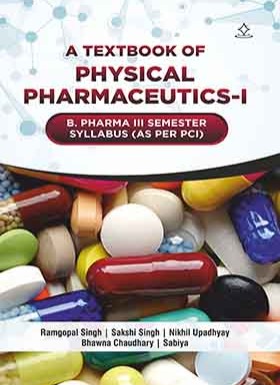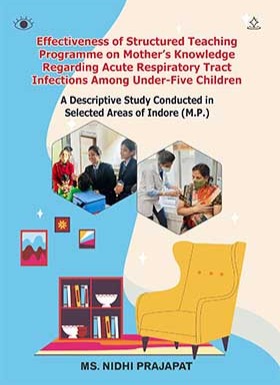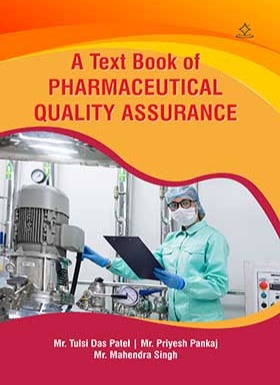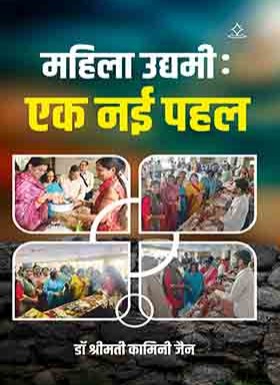About Book
Physical Pharmaceutics–I is designed for third-semester B. Pharmacy students to provide a strong foundation in the physicochemical principles essential for pharmaceutical formulation and stability. The book emphasizes how the physical and chemical properties of drugs influence their solubility, absorption, and overall therapeutic performance.
The text begins with solubility, exploring the factors that affect it, such as temperature, pH, co-solvents, and complexation. The concept of partition coefficient is explained to highlight its role in drug absorption and formulation design.
The second unit addresses the states of matter, covering gases, liquids, and solids, and explaining their characteristics, phase transitions, and pharmaceutical significance. Topics such as polymorphism, crystallinity, and viscosity are discussed to illustrate how the physical form of a substance affects stability, processing, and dosage form performance.
The third unit focuses on surface tension and interfacial phenomena, including adsorption, surfactants, wetting agents, micelle formation, and the HLB system. These principles are critical in developing stable emulsions, suspensions, and other liquid and semisolid dosage forms.
The fourth unit covers complexation and protein binding, detailing the types of complexes, analytical methods, and the impact of drug–protein interactions on distribution and bioavailability.
The final unit explores pH, buffer systems, and isotonic solutions, emphasizing their importance in maintaining drug stability, compatibility, and patient safety.
Through a combination of clear theory and practical applications, Physical Pharmaceutics–I equips students with the essential knowledge and skills required for advanced pharmaceutics, formulation development, and biopharmaceutics, bridging the gap between fundamental concepts and real-world pharmaceutical practice.
About Author
1-Ramgopal Singh is an Assistant Professor at the Mangalayatan Institute of Pharmaceutical Education and Research, Mangalayatan University, Aligarh, Uttar Pradesh, India. With over 4.5 years of teaching and research experience, he has contributed significantly to pharmaceutical education and research.
He holds a B.Pharma and M.Pharma in Pharmaceutics from GLA University and is currently pursuing a Ph.D. at Mangalayatan University, Aligarh, UP. He has actively participated in numerous conferences, seminars, webinars, and faculty development programs (FDPs). He has published several research and review articles in reputed Scopus-indexed journals.
He is also the author of “A Textbook of Pharmaceutics” for Diploma First-Year students, reflecting his dedication to making pharmaceutical education accessible and practical. His expertise spans drug formulation, physical pharmaceutics, and biopharmaceutics, and he continues to mentor students in both theoretical and practical aspects of pharmacy.
2-Miss Sakshi Singh is an Assistant Professor in the Department of Pharmaceutics at Aligarh College of Pharmacy, affiliated with Abdul Kalam Technical University, Lucknow. She holds a B.Pharm from Aligarh College of Pharmacy and an M.Pharm in Physical Pharmaceutics from GLA University, Mathura, with over 2 years of teaching experience at the undergraduate level.
Her research interests include nutraceuticals, drug delivery systems, and preclinical pharmacology. She has published review articles in Bentham Science journals, including studies on hesperidin’s neuroprotective potential and nutraceutical interventions in Parkinson’s disease, and a research paper on polymer-hesperidin hydrogel for wound healing in Drug Development and Industrial Pharmacy.
With her expertise in the PCI syllabus and industry-academia requirements, she authored Physical Pharmaceutics – I, designed to provide B.Pharm Semester III students with clear, exam-oriented content, including illustrative examples, tables, figures, and model questions. She actively participates in national and international conferences, faculty training programs, and campus activities, including the discipline committee.
3-Mr. Nikhil Upadhyay holds a B.Pharm from R.G. College of Pharmacy, Hathras, and an M.Pharm from Rajiv Academy for Pharmacy, Mathura, under Dr. A.P.J. Abdul Kalam Technical University, Lucknow. His postgraduate research focused on the formulation, optimization, and characterization of solid dispersions of Nebivolol Hydrochloride, highlighting his expertise in pharmaceutics and drug delivery systems.
He is currently serving at Aligarh College of Pharmacy, Aligarh, contributing to the academic and professional development of pharmacy students. Mr. Upadhyay has actively participated in national and international conferences, enriching his knowledge and engagement with advancements in pharmaceutical sciences.
With a thorough understanding of the PCI syllabus and industry-academia requirements, he authored Physical Pharmaceutics – I, providing B.Pharm Semester III students with clear, exam-oriented content, including illustrative examples, tables, figures, and model questions.
4-Bhawna Chaudhary is an Assistant Professor in the Department of Pharmacy at the Institute of Bio-Medical Education and Research, Aligarh, Uttar Pradesh, India. She has over 3 years of teaching experience and specializes in Pharmaceutics.
She holds a B.Pharm from Aligarh College of Pharmacy, Aligarh, and an M.Pharm in the branch of Pharmaceutics from GLA University, Mathura, UP. She is currently pursuing her Ph.D. at Mangalayatan University, Aligarh.
She has actively participated in numerous conferences, seminars, webinars, and faculty development programs (FDPs), and is currently engaged in research projects in the pharmaceutical field, contributing to both academic and practical advancements in pharmacy education. She is also the co-author of “A Textbook of Pharmaceutics” for Diploma First-Year students, reflecting her dedication to making pharmaceutical education accessible and practical.
5-Sabiya holds a B.Pharm from Dr. A.P.J. Abdul Kalam Technical University, Lucknow and an M.Pharm in Pharmaceutics from H.N.B. Garhwal Central University. She is currently working as a Patient Counselor in Tappal, where she actively engages in patient counseling, pharmacovigilance, and international health management, giving her a strong bench-to-bedside perspective.
Her research background includes Nobel-level innovation, where she developed a novel formulation for chemobrain and validated it using zebrafish behavioral assays such as the Novel Tank Test (NTT) and T-maze. She further conducted biochemical and oxidative stress marker analysis (LPO, ROS, GSH, MDA, etc.), demonstrating her command of mechanistic evaluation in drug research.
In addition, she has ensured strict ethical compliance (IBSC/IAEC) in animal handling and contributed to nanotechnology and biomedical formulation development, showcasing a strong foundation in both research and practical pharmaceutics.
With this diverse expertise, Sabiya authors Physical Pharmaceutics as a powerful integration of drug formulation science, physical principles, nanotechnology, and real-world therapeutic application, creating a resource valuable for students, researchers, pharmacists, and healthcare professionals.







